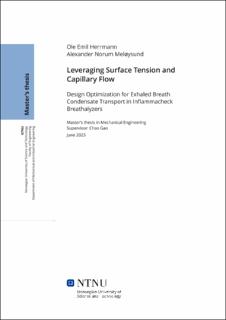| dc.contributor.advisor | Gao, Chao | |
| dc.contributor.author | Herrmann, Ole Emil | |
| dc.contributor.author | Meløysund, Alexander Norum | |
| dc.date.accessioned | 2023-10-25T17:19:40Z | |
| dc.date.available | 2023-10-25T17:19:40Z | |
| dc.date.issued | 2023 | |
| dc.identifier | no.ntnu:inspera:146039120:34673473 | |
| dc.identifier.uri | https://hdl.handle.net/11250/3098771 | |
| dc.description.abstract | I denne masteroppgaven brukes en utforskende metode for å adressere utfordringen med å samle og transportere kondensert pust (EBC) effektivt i Inflammacheck pust-analysatoren. Denne enheten, som er utviklet av Zimmer og Peacock, benyttes til noninvasiv overvåking av luftveisforhold gjennom analyse av EBC. I starten av oppgaven gjennomgås ulike krefter og fenomener for å finne hensiktsmessige mekanismer for oppbevaring og frigjøring av væske. Gjennom denne prosessen blir det tydelig at det er kritisk å forstå balansen mellom gravitasjon og overflatespenning, og oppgaven konsentrerer seg om hvordan geometriske parametere og materialeegenskaper påvirker disse kreftene.
Et "Timeglass-konsept" er skapt med dette fokuset, som drar nytte av kapillærkrefter i kanaler med både innsnevrende og utvidende geometri. Gjennom teoretiske modeller, numeriske simuleringer og praktiske forsøk, oppnås en grunnleggende forståelse av hvordan kontaktvinkler, kanalgeometri og kanalens overflateeegenskaper spiller sammen. Det blir demonstrert at ved å justere disse variablene kan man oppnå en viss kontroll over væskens posisjon i kanalen, noe som kan peke mot grunnleggende designprinsipper for utforming av systemer som utnytter kapillærkrefter.
Oppgaven identifiserer også overflateruhet som en betydelig hindring for ideell kapillærstrøm. Det er et tydelig avvik mellom teoretiske antakelser og de eksperimentelle resultatene, hovedsakelig på grunn av overflateruhet. Dette understreker viktigheten av å velge materialer of produksjonsmetoder med omhu, og at glatte overflater bør priotiteres.
Oppsummert representerer denne masteroppgaven en begynnelse for utforskning av balansen mellom gravitasjon og overflatespenning i forbindelse med oppsamling og frigjøring av EBC i puste-analysatorer som Inflammacheck. Undersøkelsen danner et fundament ved å gi en første innsikt i hvordan overflatespenning og geometriske parametere spiller inn, samtidig som den påpeker begrensningene som overflateruhet medfører. Resultatene antyder at det er behov for mer omfattende undersøkelser og videreutvikling i fremtidige studier for å kunne anvende dette i praksis. | |
| dc.description.abstract | In this master’s thesis, the challenge of efficiently and exactly collecting and transporting exhaled breath condensate (EBC) in the sensor cartridge of the Inflammacheck breathalyzer is studied. The Inflammacheck breathalyzer is a device developed by Zimmer and Peacock for non-invasive monitoring of respiratory conditions through the analysis of EBC. In a preliminary study, an initial exploration of various forces and phenomena is performed to discern feasible mechanisms for the retention and release of liquid. Through this preliminary study, it becomes evident that understanding the balance between gravitational and surface tension forces in the sensor cartridge is pivotal, and the study converges to analyzing how geometric parameters and material properties influence these forces.
An ’Hourglass Concept’ is conceived with this focus, utilizing capillary action within converging and diverging channels. Analytical calculations, numerical simulations, and practical experiments provide a foundational understanding of the interplay between the surface tension of the condensate, channel geometries, and channel surface properties. It is demonstrated that manipulating these variables imparts a degree of control over the equilibrium position of the liquid within the channel, which gives guiding principles for the design of systems harnessing capillary forces.
Additionally, the study identifies surface roughness as a substantial constraint in achieving ideal capillary flow. There is a deviation between theoretical predictions and experimental results, attributed mainly to surface roughness, emphasizing the necessity for judicious material selection and manufacturing methods, preferably aiming at smooth surfaces.
In summary, this thesis constitutes an initial exploration into balancing gravitational and surface tension forces for EBC retention and release in breathalyzers like the Inflammacheck. The investigation lays the groundwork by presenting preliminary insights into the role of surface tension and geometric parameters within capillary flow while cautioning against the constraints posed by surface roughness. The findings call for further investigation and refinement in subsequent studies to increase practical applications. | |
| dc.language | eng | |
| dc.publisher | NTNU | |
| dc.title | Leveraging Surface Tension and Capillary Flow: Design Optimization for Exhaled Breath Condensate Transport in Inflammacheck Breathalyzers | |
| dc.type | Master thesis | |
